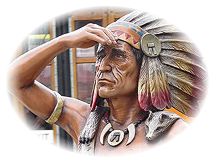
Poor Kaw-Liga.
Today, we tend to see them more in antique shops than on sidewalks. But at one time, the “cigar store Indian” was as ubiquitous as a barber pole.
Native Americans introduced tobacco to European settlers in the 1600s, and the “miracle” plant eventually made its way back across the Atlantic. Not everyone could read back then, so most shops used graphic imagery to advertise their product. Europeans associated cigars with Indians, so shops began to display wood-carved figures of Native Americans to indicate that they sold tobacco products. The early statues were often referred to as “Virginians,” since that’s where most of the tobacco came from, and not many Europeans had ever seen an American Indian. Over time, the statues got larger and more elaborate, with headdresses made from tobacco leaves and even little papooses added onto the back.
In the 19th century, American merchants had similar problems advertising their services. Mass immigration had brought plenty of consumers to the country, but not all of them spoke English. So pharmacists displayed an oversized mortar and pestle, cobblers placed a large shoe in their window, and tobacconists used the now-familiar wooden Indian to lure customers into their stores. Eventually, sidewalk obstruction laws in many towns forced shops to pull “Irving Two Smokes” out of the public walkways, although most cigar shops still have one of these sculptures on display inside, just for the sake of tradition.
Sunday, December 10, 2006
Cigar-Store Indian
Posted by alilbit at 12:58 PM
Subscribe to:
Post Comments (Atom)


0 comments:
Post a Comment